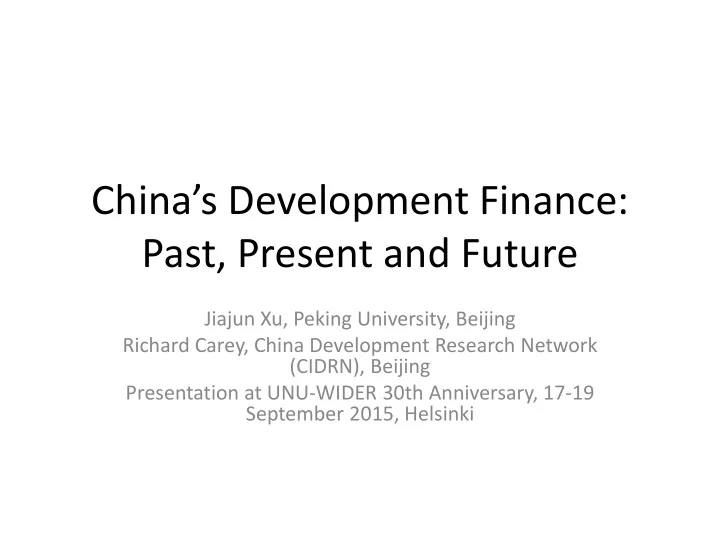

China’s Development Finance: Past, Present and Future Jiajun Xu, Peking University, Beijing Richard Carey, China Development Research Network (CIDRN), Beijing Presentation at UNU-WIDER 30th Anniversary, 17-19 September 2015, Helsinki
Creative Destruction in the Development Finance Industry • China’s two parallel development cooperations systems: China’s traditional aid programme - funded by fiscal transfers (the foreign aid budget of $3bn) China’s Policy Banks – ExIm Bank and China Development Bank funded by renminbi bond issues with sovereign guarantees making China the largest single source of development finance in the world • Creative destruction in the global development finance industry: financing economic transformation – Welfare transfers (DAC) versus mutual benefit (South South) – Fiscal transfers (aid) versus financial engineering (development finance) Impacts: ODA Definition reform Revitalisation of development banks (Addis Ababa Action Agenda) MDBs – from Billions to Trillions Report and AAAA mandate Debt Sustainability Frameworks
Trade and Development and the role of Public Entrepreneurship Public Entrepreneurship (or the Developmental State/Learning society -Stiglitz or the Facilitating State – Justin Lin) – -the public action needed to create and sustain a dynamic market economy – Vision, action, innovation Our trade and development models have been seriously incomplete and wrong need soft and hard infrastructure plus human capital (Ron Finlay, Adam Smith) efforts required here have been vastly underestimated (look at what we need and do in developed countries to advance and support the market economy via public entrepreneuship) Africa without any of this investment for two decades Opening the way for predatory leaders/elites who set back the whole agenda and cause huge misery
The Financial Engineering Behind China’s Superfast Growth 1980s: agriculture – bottom up land tenure reform, rural economic development, on farm investment from family labour Infrastructure and industry – ODA loans – Japan, other donors, World Bank, Asian Development Bank China as a fast learner from its donors, including technique of resource backed development loans from Japan, and key learnings from the World Bank. 1990s: Policy Banks established in 1994 – China Development Bank; Agricultural Development Bank; ExIM Bank sovereign guarantees and financial leverage in a repressed financial system China Development Bank Story The financing of China’s « Lewis process » (urbanisation), SEZs and regional development Tax reform of 1994 and the invention of the Local Government Financing Vehicles (LGFVs) by the CDB Based on land requisition and sale FDI plus export orientation plus urbanisation – the learning by doing economy and dynamic capacity development Robert Lucas: On the Mechanics of Economic Growth (1988) urbanisation/ cities as universities/ agglomeration (not in the neo classical model)
China as a Global Public Entrepreneur Today Understanding China today • Not state capitalism: a private sector driven entrepreneurial society (cf Economist on Business in China) China’s Disruptors (Edward Tse) – new business models of Chinese entrepreneurs with global impact • Public entrepreneurship: the reform programme of 2013 – rebalancing – innovation-driven development strategy (Li Keqiqng/Edmund Phelps) • China as a new architect in the international development system • 4 new development banks (AIIB, NDB, Shanghai Cooperation Organisation Bank, Silk Roads Fund • 3 new regional initiatives - linking China – Africa modernization; Silk Roads; Latin America • 2 new forums – International Knowledge Centre for Global Development; Silk Road Think Tank Network • Creating new economic landscapes – thinking in large terms of economic geography – working with others • Geopolitical dimensions and global governance of development cooperation (Xu and Carey, Journal of International Development, August 2015)
China and the SDGs • China’s quest for a green economy generating green industrial capacities and solutions • China’s capacities in the mobile internet industry – engineering and new content models • China’s capacities in urbanisation and industrialisation (exporting the Lewis model) • Development Cooperation Transparency and Reform
Towards a Global Reporting System for the SDGs • Transformation Potential and Impact (TPI) • A reporting system for all that builds in incentives for transformational thinking and programme design to creat systemic capacities, do real time evauation and work with others and across silos • Xu and Carey IDS Working Paper next week
Recommend
More recommend